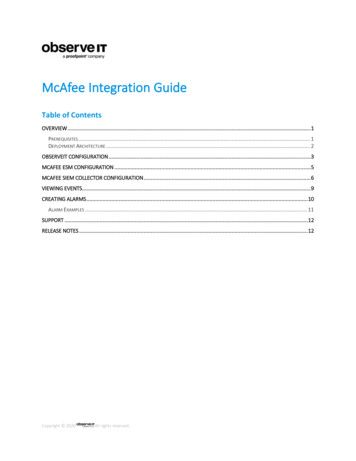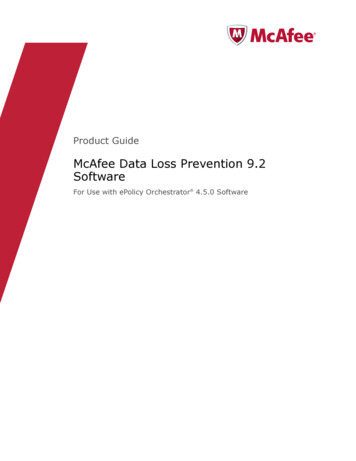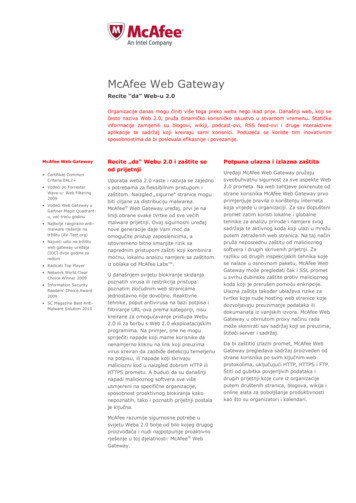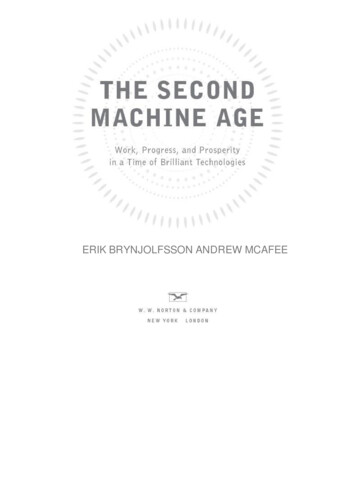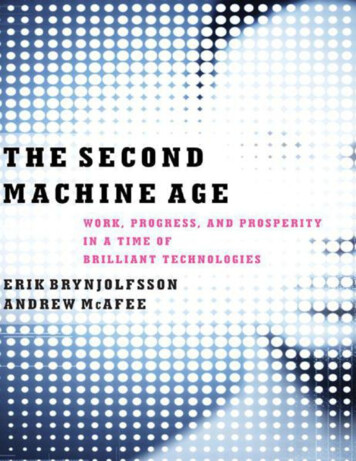
Transcription
ERIK BRYNJOLFSSON ANDREW MCAFEE
To Martha Pavlakis, the love of my life.To my parents, David McAfee and Nancy Haller, who prepared me forthe second machine age by giving me every advantage a personcould have.
Chapter 1 THE BIG STORIESChapter 2 THE SKILLS OF THE NEW MACHINES: TECHNOLOGYRACES AHEADChapter 3 MOORE’S LAW AND THE SECOND HALF OF THECHESSBOARDChapter 4 THE DIGITIZATION OF JUST ABOUT EVERYTHINGChapter 5 INNOVATION: DECLINING OR RECOMBINING?Chapter 6 ARTIFICIAL AND HUMAN INTELLIGENCE IN THESECOND MACHINE AGEChapter 7 COMPUTING BOUNTYChapter 8 BEYOND GDPChapter 9 THE SPREADChapter 10 THE BIGGEST WINNERS: STARS AND SUPERSTARS
Chapter 11 IMPLICATIONS OF THE BOUNTY AND THE SPREADChapter 12 LEARNING TO RACE WITH MACHINES:RECOMMENDATIONS FOR INDIVIDUALSChapter 13 POLICY RECOMMENDATIONSChapter 14 LONG-TERM RECOMMENDATIONSChapter 15 TECHNOLOGY AND THE FUTURE(Which Is Very Different from “Technology Is the Future”)AcknowledgmentsNotesIllustration SourcesIndex
“Technology is a gift of God. After the gift of life it is perhaps the greatest of God’sgifts. It is the mother of civilizations, of arts and of sciences.”—Freeman Dyson
WHAT HAVE BEEN THE most important developments in human history?As anyone investigating this question soon learns, it’s difficult to answer.For one thing, when does ‘human history’ even begin? Anatomically andbehaviorally modern Homo sapiens, equipped with language, fanned outfrom their African homeland some sixty thousand years ago.1 By 25,000BCE2 they had wiped out the Neanderthals and other hominids, and thereafterfaced no competition from other big-brained, upright-walking species.We might consider 25,000 BCE a reasonable time to start tracking the bigstories of humankind, were it not for the development-retarding ice age earthwas experiencing at the time.3 In his book Why the West Rules—For Now,anthropologist Ian Morris starts tracking human societal progress in 14,000BCE, when the world clearly started getting warmer.Another reason it’s a hard question to answer is that it’s not clear whatcriteria we should use: what constitutes a truly important development? Mostof us share a sense that it would be an event or advance that significantlychanges the course of things—one that ‘bends the curve’ of human history.Many have argued that the domestication of animals did just this, and is oneof our earliest important achievements.The dog might well have been domesticated before 14,000 BCE, but thehorse was not; eight thousand more years would pass before we startedbreeding them and keeping them in corrals. The ox, too, had been tamed bythat time (ca. 6,000 BCE) and hitched to a plow. Domestication of workanimals hastened the transition from foraging to farming, an importantdevelopment already underway by 8,000 BCE.4Agriculture ensures plentiful and reliable food sources, which in turnenable larger human settlements and, eventually, cities. Cities in turn maketempting targets for plunder and conquest. A list of important humandevelopments should therefore include great wars and the empires theyyielded. The Mongol, Roman, Arab, and Ottoman empires—to name justfour—were transformative; they affected kingdoms, commerce, and customsover immense areas.Of course, some important developments have nothing to do with animals,
plants, or fighting men; some are simply ideas. Philosopher Karl Jaspersnotes that Buddha (563–483 BCE), Confucius (551–479 BCE), and Socrates(469–399 BCE) all lived quite close to one another in time (but not in place).In his analysis these men are the central thinkers of an ‘Axial Age’ spanning800–200 BCE. Jaspers calls this age “a deep breath bringing the most lucidconsciousness” and holds that its philosophers brought transformativeschools of thought to three major civilizations: Indian, Chinese, andEuropean.5The Buddha also founded one of the world’s major religions, and commonsense demands that any list of major human developments include theestablishment of other major faiths like Hinduism, Judaism, Christianity, andIslam. Each has influenced the lives and ideals of hundreds of millions ofpeople.6Many of these religions’ ideas and revelations were spread by the writtenword, itself a fundamental innovation in human history. Debate rages aboutprecisely when, where, and how writing was invented, but a safe estimateputs it in Mesopotamia around 3,200 BCE. Written symbols to facilitatecounting also existed then, but they did not include the concept of zero, asbasic as that seems to us now. The modern numbering system, which we callArabic, arrived around 830 CE.7The list of important developments goes on and on. The Athenians beganto practice democracy around 500 BCE. The Black Death reduced Europe’spopulation by at least 30 percent during the latter half of the 1300s.Columbus sailed the ocean blue in 1492, beginning interactions between theNew World and the Old that would transform both.The History of Humanity in One GraphHow can we ever get clarity about which of these developments is the mostimportant? All of the candidates listed above have passionate advocates—people who argue forcefully and persuasively for one development’ssovereignty over all the others. And in Why the West Rules—For Now Morrisconfronts a more fundamental debate: whether any attempt to rank orcompare human events and developments is meaningful or legitimate. Manyanthropologists and other social scientists say it is not. Morris disagrees, and
his book boldly attempts to quantify human development. As he writes,“reducing the ocean of facts to simple numerical scores has drawbacks but italso has the one great merit of forcing everyone to confront the sameevidence—with surprising results.”8 In other words, if we want to knowwhich developments bent the curve of human history, it makes sense to try todraw that curve.Morris has done thoughtful and careful work to quantify what he termssocial development (“a group’s ability to master its physical and intellectualenvironment to get things done”) over time.* As Morris suggests, the resultsare surprising. In fact, they’re astonishing. They show that none of thedevelopments discussed so far has mattered very much, at least incomparison to something else—something that bent the curve of humanhistory like nothing before or since. Here’s the graph, with total worldwidehuman population graphed over time along with social development; as youcan see, the two lines are nearly identical:FIGURE 1.1 Numerically Speaking, Most of Human History Is Boring.For many thousands of years, humanity was a very gradual upward
trajectory. Progress was achingly slow, almost invisible. Animals and farms,wars and empires, philosophies and religions all failed to exert muchinfluence. But just over two hundred years ago, something sudden andprofound arrived and bent the curve of human history—of population andsocial development—almost ninety degrees.Engines of ProgressBy now you’ve probably guessed what it was. This is a book about theimpact of technology, after all, so it’s a safe bet that we’re opening it this wayin order to demonstrate how important technology has been. And the suddenchange in the graph in the late eighteenth century corresponds to adevelopment we’ve heard a lot about: the Industrial Revolution, which wasthe sum of several nearly simultaneous developments in mechanicalengineering, chemistry, metallurgy, and other disciplines. So you’ve mostlikely figured out that these technological developments underlie the sudden,sharp, and sustained jump in human progress.If so, your guess is exactly right. And we can be even more precise aboutwhich technology was most important. It was the steam engine or, to be moreprecise, one developed and improved by James Watt and his colleagues in thesecond half of the eighteenth century.Prior to Watt, steam engines were highly inefficient, harnessing only aboutone percent of the energy released by burning coal. Watt’s brilliant tinkeringbetween 1765 and 1776 increased this more than threefold.9 As Morriswrites, this made all the difference: “Even though [the steam] revolution tookseveral decades to unfold . . . it was nonetheless the biggest and fastesttransformation in the entire history of the world.”10The Industrial Revolution, of course, is not only the story of steam power,but steam started it all. More than anything else, it allowed us to overcomethe limitations of muscle power, human and animal, and generate massiveamounts of useful energy at will. This led to factories and mass production, torailways and mass transportation. It led, in other words, to modern life. TheIndustrial Revolution ushered in humanity’s first machine age—the first timeour progress was driven primarily by technological innovation—and it wasthe most profound time of transformation our world has ever seen.* The
ability to generate massive amounts of mechanical power was so importantthat, in Morris’s words, it “made mockery of all the drama of the world’searlier history.”11FIGURE 1.2 What Bent the Curve of Human History? The Industrial Revolution.Now comes the second machine age. Computers and other digitaladvances are doing for mental power—the ability to use our brains tounderstand and shape our environments—what the steam engine and itsdescendants did for muscle power. They’re allowing us to blow past previouslimitations and taking us into new territory. How exactly this transition willplay out remains unknown, but whether or not the new machine age bendsthe curve as dramatically as Watt’s steam engine, it is a very big deal indeed.This book explains how and why.For now, a very short and simple answer: mental power is at least asimportant for progress and development—for mastering our physical andintellectual environment to get things done—as physical power. So a vast andunprecedented boost to mental power should be a great boost to humanity,just as the ealier boost to physical power so clearly was.
Playing Catch-UpWe wrote this book because we got confused. For years we have studied theimpact of digital technologies like computers, software, and communicationsnetworks, and we thought we had a decent understanding of their capabilitiesand limitations. But over the past few years, they started surprising us.Computers started diagnosing diseases, listening and speaking to us, andwriting high-quality prose, while robots started scurrying around warehousesand driving cars with minimal or no guidance. Digital technologies had beenlaughably bad at a lot of these things for a long time—then they suddenly gotvery good. How did this happen? And what were the implications of thisprogress, which was astonishing and yet came to be considered a matter ofcourse?We decided to team up and see if we could answer these questions. Wedid the normal things business academics do: read lots of papers and books,looked at many different kinds of data, and batted around ideas andhypotheses with each other. This was necessary and valuable, but the reallearning, and the real fun, started when we went out into the world. We spokewith inventors, investors, entrepreneurs, engineers, scientists, and manyothers who make technology and put it to work.Thanks to their openness and generosity, we had some futuristicexperiences in today’s incredible environment of digital innovation. We’veridden in a driverless car, watched a computer beat teams of Harvard andMIT students in a game of Jeopardy!, trained an industrial robot by grabbingits wrist and guiding it through a series of steps, handled a beautiful metalbowl that was made in a 3D printer, and had countless other mind-meltingencounters with technology.Where We AreThis work led us to three broad conclusions.The first is that we’re living in a time of astonishing progress with digitaltechnologies—those that have computer hardware, software, and networks attheir core. These technologies are not brand-new; businesses have beenbuying computers for more than half a century, and Time magazine declaredthe personal computer its “Machine of the Year” in 1982. But just as it took
generations to improve the steam engine to the point that it could power theIndustrial Revolution, it’s also taken time to refine our digital engines.We’ll show why and how the full force of these technologies has recentlybeen achieved and give examples of its power. “Full,” though, doesn’t mean“mature.” Computers are going to continue to improve and to do new andunprecedented things. By “full force,” we mean simply that the key buildingblocks are already in place for digital technologies to be as important andtransformational to society and the economy as the steam engine. In short,we’re at an inflection point—a point where the curve starts to bend a lot—because of computers. We are entering a second machine age.Our second conclusion is that the transformations brought about by digitaltechnology will be profoundly beneficial ones. We’re heading into an era thatwon’t just be different; it will be better, because we’ll be able to increase boththe variety and the volume of our consumption. When we phrase it that way—in the dry vocabulary of economics—it almost sounds unappealing. Whowants to consume more and more all the time? But we don’t just consumecalories and gasoline. We also consume information from books and friends,entertainment from superstars and amateurs, expertise from teachers anddoctors, and countless other things that are not made of atoms. Technologycan bring us more choice and even freedom.When these things are digitized—when they’re converted into bits that canbe stored on a computer and sent over a network—they acquire some weirdand wonderful properties. They’re subject to different economics, whereabundance is the norm rather than scarcity. As we’ll show, digital goods arenot like physical ones, and these differences matter.Of course, physical goods are still essential, and most of us would likethem to have greater volume, variety, and quality. Whether or not we want toeat more, we’d like to eat better or different meals. Whether or not we wantto burn more fossil fuels, we’d like to visit more places with less hassle.Computers are helping accomplish these goals, and many others. Digitizationis improving the physical world, and these improvements are only going tobecome more important. Among economic historians there’s wide agreementthat, as Martin Weitzman puts it, “the long-term growth of an advancedeconomy is dominated by the behavior of technical progress.”12 As we’llshow, technical progress is improving exponentially.
Our third conclusion is less optimistic: digitization is going to bring with itsome thorny challenges. This in itself should not be too surprising oralarming; even the most beneficial developments have unpleasantconsequences that must be managed. The Industrial Revolution wasaccompanied by soot-filled London skies and horrific exploitation of childlabor. What will be their modern equivalents? Rapid and acceleratingdigitization is likely to bring economic rather than environmental disruption,stemming from the fact that as computers get more powerful, companies haveless need for some kinds of workers. Technological progress is going to leavebehind some people, perhaps even a lot of people, as it races ahead. As we’lldemonstrate, there’s never been a better time to be a worker with specialskills or the right education, because these people can use technology tocreate and capture value. However, there’s never been a worse time to be aworker with only ‘ordinary’ skills and abilities to offer, because computers,robots, and other digital technologies are acquiring these skills and abilities atan extraordinary rate.Over time, the people of England and other countries concluded that someaspects of the Industrial Revolution were unacceptable and took steps to endthem (democratic government and technological progress both helped withthis). Child labor no longer exists in the UK, and London air contains lesssmoke and sulfur dioxide now than at any time since at least the late 1500s.13The challenges of the digital revolution can also be met, but first we have tobe clear on what they are. It’s important to discuss the likely negativeconsequences of the second machine age and start a dialogue about how tomitigate them—we are confident that they’re not insurmountable. But theywon’t fix themselves, either. We’ll offer our thoughts on this important topicin the chapters to come.So this is a book about the second machine age unfolding right now—aninflection point in the history of our economies and societies because ofdigitization. It’s an inflection point in the right direction—bounty instead ofscarcity, freedom instead of constraint—but one that will bring with it somedifficult challenges and choices.This book is divided into three sections. The first, composed of chapters 1through 6, describes the fundamental characteristics of the second machineage. These chapters give many examples of recent technological progress that
seem like the stuff of science fiction, explain why they’re happening now(after all, we’ve had computers for decades), and reveal why we should beconfident that the scale and pace of innovation in computers, robots, andother digital gear is only going to accelerate in the future.The second part, consisting of chapters 7 through 11, explores bounty andspread, the two economic consequences of this progress. Bounty is theincrease in volume, variety, and quality and the decrease in cost of the manyofferings brought on by modern technological progress. It’s the besteconomic news in the world today. Spread, however, is not so great; it’s everbigger differences among people in economic success—in wealth, income,mobility, and other important measures. Spread has been increasing in recentyears. This is a troubling development for many reasons, and one that willaccelerate in the second machine age unless we intervene.The final section—chapters 12 through 15—discusses what interventionswill be appropriate and effective for this age. Our economic goals should beto maximize the bounty while mitigating the negative effects of the spread.We’ll offer our ideas about how to best accomplish these aims, both in theshort term and in the more distant future, when progress really has brought usinto a world so technologically advanced that it seems to be the stuff ofscience fiction. As we stress in our concluding chapter, the choices we makefrom now on will determine what kind of world that is.* Morris defines human social development as consisting of four attributes: energy capture(per-person calories obtained from the environment for food, home and commerce, industryand agriculture, and transportation), organization (the size of the largest city), war-makingcapacity (number of troops, power and speed of weapons, logistical capabilities, and othersimilar factors), and information technology (the sophistication of available tools for sharingand processing information, and the extent of their use). Each of these is converted into anumber that varies over time from zero to 250. Overall social development is simply the sumof these four numbers. Because he was interested in comparisons between the West(Europe, Mesopotamia, and North America at various times, depending on which was mostadvanced) and the East (China and Japan), he calculated social development separately foreach area from 14,000 BCE to 2000 CE. In 2000, the East was higher only in organization(since Tokyo was the world’s largest city) and had a social development score of 564.83. TheWest’s score in 2000 was 906.37. We average the two scores.* We refer to the Industrial Revolution as the first machine age. However, “the machine age” isalso a label used by some economic historians to refer to a period of rapid technological
progress spanning the late nineteenth and early twentieth centuries. This same period iscalled by others the Second Industrial Revolution, which is how we’ll refer to it in laterchapters.
“Any sufficiently advanced technology is indistinguishable from magic.”—Arthur C. Clarke
IN THE SUMMER OF 2012, we went for a drive in a car that had no driver.During a research visit to Google’s Silicon Valley headquarters, we got toride in one of the company’s autonomous vehicles, developed as part of itsChauffeur project. Initially we had visions of cruising in the back seat of a carthat had no one in the front seat, but Google is understandably skittish aboutputting obviously autonomous autos on the road. Doing so might freak outpedestrians and other drivers, or attract the attention of the police. So we satin the back while two members of the Chauffeur team rode up front.When one of the Googlers hit the button that switched the car into fullyautomatic driving mode while we were headed down Highway 101, ourcuriosities—and self-preservation instincts—engaged. The 101 is not alwaysa predictable or calm environment. It’s nice and straight, but it’s alsocrowded most of the time, and its traffic flows have little obvious rhyme orreason. At highway speeds the consequences of driving mistakes can beserious ones. Since we were now part of the ongoing Chauffeur experiment,these consequences were suddenly of more than just intellectual interest tous.The car performed flawlessly. In fact, it actually provided a boring ride. Itdidn’t speed or slalom among the other cars; it drove exactly the way we’reall taught to in driver’s ed. A laptop in the car provided a real-time visualrepresentation of what the Google car ‘saw’ as it proceeded along thehighway—all the nearby objects of which its sensors were aware. The carrecognized all the surrounding vehicles, not just the nearest ones, and itremained aware of them no matter where they moved. It was a car withoutblind spots. But the software doing the driving was aware that cars and trucksdriven by humans do have blind spots. The laptop screen displayed thesoftware’s best guess about where all these blind spots were and worked tostay out of them.We were staring at the screen, paying no attention to the actual road, whentraffic ahead of us came to a complete stop. The autonomous car brakedsmoothly in response, coming to a stop a safe distance behind the car in front,and started moving again once the rest of the traffic did. All the while the
Googlers in the front seat never stopped their conversation or showed anynervousness, or indeed much interest at all in current highway conditions.Their hundreds of hours in the car had convinced them that it could handle alittle stop-and-go traffic. By the time we pulled back into the parking lot, weshared their confidence.The New New Division of LaborOur ride that day on the 101 was especially weird for us because, only a fewyears earlier, we were sure that computers would not be able to drive cars.Excellent research and analysis, conducted by colleagues who we respect agreat deal, concluded that driving would remain a human task for theforeseeable future. How they reached this conclusion, and how technologieslike Chauffeur started to overturn it in just a few years, offers importantlessons about digital progress.In 2004 Frank Levy and Richard Murnane published their book The NewDivision of Labor.1 The division they focused on was between human anddigital labor—in other words, between people and computers. In any sensibleeconomic system, people should focus on the tasks and jobs where they havea comparative advantage over computers, leaving computers the work forwhich they are better suited. In their book Levy and Murnane offered a wayto think about which tasks fell into each category.One hundred years ago the previous paragraph wouldn’t have made anysense. Back then, computers were humans. The word was originally a jobtitle, not a label for a type of machine. Computers in the early twentiethcentury were people, usually women, who spent all day doing arithmetic andtabulating the results. Over the course of decades, innovators designedmachines that could take over more and more of this work; they were firstmechanical, then electro-mechanical, and eventually digital. Today, fewpeople if any are employed simply to do arithmetic and record the results.Even in the lowest-wage countries there are no human computers, becausethe nonhuman ones are far cheaper, faster, and more accurate.If you examine their inner workings, you realize that computers aren’t justnumber crunchers, they’re symbols processors. Their circuitry can beinterpreted in the language of ones and zeroes, but equally validly as true or
false, yes or no, or any other symbolic system. In principle, they can do allmanner of symbolic work, from math to logic to language. But digitalnovelists are not yet available, so people still write all the books that appearon fiction bestseller lists. We also haven’t yet computerized the work ofentrepreneurs, CEOs, scientists, nurses, restaurant busboys, or many othertypes of workers. Why not? What is it about their work that makes it harderto digitize than what human computers used to do?Computers Are Good at Following Rules . . .These are the questions Levy and Murnane tackled in The New Division ofLabor, and the answers they came up with made a great deal of sense. Theauthors put information processing tasks—the foundation of all knowledgework—on a spectrum. At one end are tasks like arithmetic that require onlythe application of well-understood rules. Since computers are really good atfollowing rules, it follows that they should do arithmetic and similar tasks.Levy and Murnane go on to highlight other types of knowledge work thatcan also be expressed as rules. For example, a person’s credit score is a goodgeneral predictor of whether they’ll pay back their mortgage as promised, asis the amount of the mortgage relative to the person’s wealth, income, andother debts. So the decision about whether or not to give someone a mortgagecan be effectively boiled down to a rule.Expressed in words, a mortgage rule might say, “If a person is requestinga mortgage of amount M and they have a credit score of V or higher, annualincome greater than I or total wealth greater than W, and total debt no greaterthan D, then approve the request.” When expressed in computer code, we calla mortgage rule like this an algorithm. Algorithms are simplifications; theycan’t and don’t take everything into account (like a billionaire uncle who hasincluded the applicant in his will and likes to rock-climb without ropes).Algorithms do, however, include the most common and important things, andthey generally work quite well at tasks like predicting payback rates.Computers, therefore, can and should be used for mortgage approval.*. . . But Lousy at Pattern Recognition
At the other end of Levy and Murnane’s spectrum, however, lie informationprocessing tasks that cannot be boiled down to rules or algorithms. Accordingto the authors, these are tasks that draw on the human capacity for patternrecognition. Our brains are extraordinarily good at taking in information viaour senses and examining it for patterns, but we’re quite bad at describing orfiguring out how we’re doing it, especially when a large volume of fastchanging information arrives at a rapid pace. As the philosopher MichaelPolanyi famously observed, “We know more than we can tell.”2 When this isthe case, according to Levy and Murnane, tasks can’t be computerized andwill remain in the domain of human workers. The authors cite driving avehicle in traffic as an example of such as task. As they write,As the driver makes his left turn against traffic, he confronts a wall of images and soundsgenerated by oncoming cars, traffic lights, storefronts, billboards, trees, and a trafficpoliceman. Using his knowledge, he must estimate the size and position of each of theseobjects and the likelihood that they pose a hazard. . . . The truck driver [has] the schemato recognize what [he is] confronting. But articulating this knowledge and embedding it insoftware for all but highly structured situations are at present enormously difficult tasks. . . Computers cannot easily substitute for humans in [jobs like driving].So Much for That DistinctionWe were convinced by Levy and Murnane’s arguments when we read TheNew Division of Labor in 2004. We were further convinced that year by theinitial results of the DARPA Grand Challenge for driverless cars.DARPA, the Defense Advanced Research Projects Agency, was foundedin 1958 (in response to the Soviet Union’s launch of the Sputnik satellite) andtasked with spurring technological progress that might have militaryapplications. In 2002 the agency announced its first Grand Challenge, whichwas to build a completely autonomous vehicle that could complete a 150mile course through California’s Mojave Desert. Fifteen entrants performedwell enough in a qualifying run to compete in the main event, which was heldon March 13, 2004.The results were less than encouraging. Two vehicles didn’t make it to thestarting area, one flipped over in the starting area, and three hours into therace only four cars were still operational. The “winning” Sandstorm car fromCarnegie Mellon University covered 7.4 miles (less than 5 percent of the
total) before veering off the course during a hairpin turn and getting stuck onan embankment. The contest’s 1 million prize went unclaimed, and PopularScience called the event “DARPA’s Debacle in the Desert.”3Within a few years, however, the debacle in the desert became the ‘fun onthe 101’ that we experienced. Google announced in an October 2010 blogpost that its completely autonomous cars had for some time been drivingsuccessfully, in traffic, on American roads and highways. By the time wetook our ride in the summer of 2012 the Chauffeur project had grown into asmall fleet of vehicles that had collectively logged hundreds of thousands ofmiles with no human involvement and with only tw
developments should therefore include great wars and the empires they yielded. The Mongol, Roman, Arab, and Ottoman empires—to name just four—were transformative; they affected kingdoms, commerce, and customs over immense areas. Of course, some important developments have nothing to do with animals,



